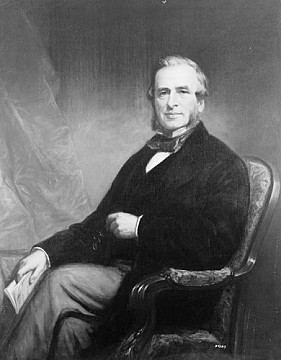Robert Bowne Minturn (1805-1866)
Shipping Merchant, of Grinnell, Minturn & Co., Owner of the 'Flying Cloud'
He was born on Pearl Street in New York City and was named for his maternal grandfather, Robert Bowne, founder of Bowne & Co., Stationers, and co-founder of the American Chamber of Commerce and the Bank of New York. He had hoped to go to university to become a physician but his father's fortune was ruined by the War of 1812 and at the age of fifteen (1820) he followed in the footsteps of his father and grandfather by going into shipping, starting as a clerk in a counting house. In 1830, he joined the firm of Fish & Grinnell - Cornelius Grinnell's son, Henry, having married his sister. When the two senior partners retired in 1831, he and another of Grinnell's son, Moses Hicks Grinnell, continued the firm as Grinnell, Minturn & Co. It quickly became one of America’s most important shipping lines with a fleet of 50-ships noted for their speed and size trading between New York and Liverpool and New York and London.
Their profits were significantly bolstered as a result of the Potato Famine in Ireland (1845-49) when they transported a large percentage of the one million or so immigrants who fled to America; and, again with the Gold Rush in 1849 when they established a new line to take thousands of hopeful prospectors to California. They paid $90,000 for the clipper Flying Cloud that on its maiden voyage in 1851 sailed around Cape Horn to San Francisco in 89-days, 21-hours, breaking the previous record by a full week. In 1853, it beat its own record, making the journey in 81-days, 8-hours - a record that stood for 100-years.
Having been brought up as a Quaker, Minturn vehemently opposed slavery and was reported to have travelled to the south to buy slaves simply to set them free. It was also said that he built a model apartment house for one hundred poor African-American families in what is now New York’s Chinatown. He declined all offers of public service except the post of Commissioner of Emigration, purely because of his strong desire to secure the rights of immigrants. He was actively involved in several charities, notably the Freedman's Association, and he co-founded St. Luke's Hospital and the Association for Improving the Condition of the Poor in New York City. He was also the first President of the Union League Club set up in support of Lincoln and the Union during the Civil War.
In 1835, he married Anna, daughter of John Lansing Wendell, Judge and Reporter of the Supreme Court of the State of New York. They had eight children (listed), seven of whom survived childhood, and lived between 60 Fifth Avenue (see images) in Manhattan and "Locust Wood" their 173-acre estate (now Zinsser Park) in Hastings-on-Hudson. In 1848, the Minturns took an 18-month Grand Tour of Europe, visiting Jerusalem and Egypt too. Inspired by the public parks they had seen in London, Paris and Vienna, Mrs. Minturn urged her husband to call together a committee to lobby for a public park in New York, and for that purpose they donated a large portion of the land that became Central Park. Eulogized at his death as an "American gentleman," he left an estate of $1-million.
Their profits were significantly bolstered as a result of the Potato Famine in Ireland (1845-49) when they transported a large percentage of the one million or so immigrants who fled to America; and, again with the Gold Rush in 1849 when they established a new line to take thousands of hopeful prospectors to California. They paid $90,000 for the clipper Flying Cloud that on its maiden voyage in 1851 sailed around Cape Horn to San Francisco in 89-days, 21-hours, breaking the previous record by a full week. In 1853, it beat its own record, making the journey in 81-days, 8-hours - a record that stood for 100-years.
Having been brought up as a Quaker, Minturn vehemently opposed slavery and was reported to have travelled to the south to buy slaves simply to set them free. It was also said that he built a model apartment house for one hundred poor African-American families in what is now New York’s Chinatown. He declined all offers of public service except the post of Commissioner of Emigration, purely because of his strong desire to secure the rights of immigrants. He was actively involved in several charities, notably the Freedman's Association, and he co-founded St. Luke's Hospital and the Association for Improving the Condition of the Poor in New York City. He was also the first President of the Union League Club set up in support of Lincoln and the Union during the Civil War.
In 1835, he married Anna, daughter of John Lansing Wendell, Judge and Reporter of the Supreme Court of the State of New York. They had eight children (listed), seven of whom survived childhood, and lived between 60 Fifth Avenue (see images) in Manhattan and "Locust Wood" their 173-acre estate (now Zinsser Park) in Hastings-on-Hudson. In 1848, the Minturns took an 18-month Grand Tour of Europe, visiting Jerusalem and Egypt too. Inspired by the public parks they had seen in London, Paris and Vienna, Mrs. Minturn urged her husband to call together a committee to lobby for a public park in New York, and for that purpose they donated a large portion of the land that became Central Park. Eulogized at his death as an "American gentleman," he left an estate of $1-million.
Parents (2)
Spouse (1)
Children (8)
Categories
Share
- Image Courtesy of the Frick Art Reference Library
- “Love, Fiercely: A Gilded Age Romance" by Jean Zimmerman
- https://daytoninmanhattan.blogspot.com/2014/08/the-lost-minturn-mansion-no-60-5th.html








